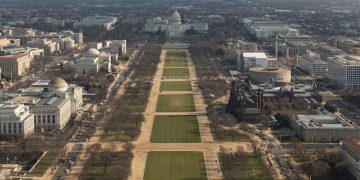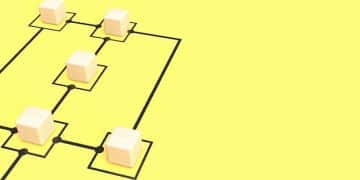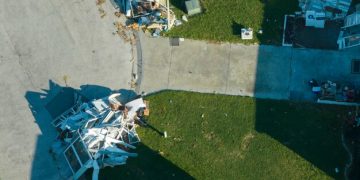Examining US Efforts Against Disinformation in Conflict Zones

Examining the US Government’s Efforts to Combat Disinformation and Propaganda in Conflict Zones reveals a multifaceted approach involving strategic communication, technical partnerships, and international collaborations aimed at undermining false narratives that fuel global conflicts.
The proliferation of disinformation and propaganda in conflict zones poses a significant threat to international security and stability. This article delves into examining the US Government’s Efforts to Combat Disinformation and Propaganda in Conflict Zones, assessing its strategies, challenges, and effectiveness in mitigating the harmful effects of false narratives.
Understanding the Landscape of Disinformation
Disinformation, the deliberate spread of false or misleading information, has become a pervasive tool in modern conflict. Understanding its nuances and impact is crucial for developing effective countermeasures. The US government recognizes the critical role of combating disinformation to protect its interests and allies in conflict zones.
The Nature of Disinformation in Conflict
In conflict zones, disinformation serves multiple purposes, including inciting violence, undermining trust in legitimate institutions, and manipulating public opinion. Its rapid spread through social media and other digital platforms amplifies its impact, making it difficult to contain.
The Impact on International Security
The spread of disinformation can destabilize entire regions, escalate conflicts, and erode diplomatic efforts. By fostering distrust and polarization, disinformation can undermine peace processes and prolong instability, making it a significant threat to international security.
- Undermines trust in institutions and governments.
- Exacerbates social and political divisions.
- Hinders humanitarian efforts by spreading false information about aid organizations.
- Increases the risk of violence and radicalization.
Ultimately, combating disinformation requires a comprehensive understanding of its sources, methods, and impacts. The US government’s efforts are aimed at addressing these multifaceted challenges through various strategic initiatives.

US Government Strategies to Counter Disinformation
The US government employs a range of strategies to counter disinformation and propaganda in conflict zones. These efforts span diplomatic, technical, and informational domains, reflecting a comprehensive approach to addressing this complex challenge. Key strategies include strategic communication, public diplomacy, and technical partnerships.
Strategic Communication and Public Diplomacy
Strategic communication involves crafting and disseminating accurate information to counter false narratives. Public diplomacy efforts aim to engage with local populations, build trust, and promote US values. These initiatives are crucial for shaping perceptions and countering propaganda in conflict zones.
Technical Partnerships and Innovation
The US government collaborates with tech companies and research institutions to develop tools and technologies for detecting and countering disinformation. These partnerships leverage cutting-edge technology to identify and dismantle disinformation networks, enhancing the overall effectiveness of counter-disinformation efforts.
- Developing advanced algorithms to detect and flag disinformation.
- Supporting initiatives to promote media literacy and critical thinking.
- Working with social media platforms to remove false and misleading content.
- Providing technical assistance to journalists and fact-checkers in conflict zones.
Through these multifaceted strategies, the US government seeks to create a more resilient information environment, empowering individuals to discern truth from falsehood and reducing the impact of disinformation in conflict zones.
The Role of Technology in Combating Disinformation
Technology plays a pivotal role in both the spread and the combat of disinformation. Advanced tools and platforms are essential for identifying, tracking, and countering disinformation campaigns. The US government leverages technology to enhance its counter-disinformation efforts, working closely with tech companies and research institutions.
Advanced AI and Machine Learning
Artificial intelligence (AI) and machine learning (ML) algorithms are used to analyze vast amounts of data and identify patterns indicative of disinformation campaigns. These technologies can detect fake accounts, bot networks, and manipulated content, enabling rapid response and mitigation.
Social Media Monitoring and Analysis
Monitoring social media platforms is crucial for identifying emerging disinformation trends and assessing their potential impact. Sophisticated analytics tools are used to track the spread of false narratives, identify influential actors, and gauge public sentiment.
- Developing AI-powered tools to detect deepfakes and manipulated media.
- Using natural language processing (NLP) to analyze the sentiment and credibility of online content.
- Creating secure communication channels for journalists and activists in conflict zones.
- Supporting open-source intelligence (OSINT) initiatives to uncover disinformation networks.
By harnessing the power of technology, the US government enhances its ability to detect, analyze, and counter disinformation effectively, contributing to a more secure and informed global environment.

International Collaboration and Partnerships
Combating disinformation requires a global effort, involving collaboration between governments, international organizations, and civil society. The US government actively engages in international partnerships to share best practices, coordinate strategies, and enhance collective resilience against disinformation threats. These collaborations are vital for addressing the global nature of disinformation campaigns.
Working with Allied Nations
The US government works closely with allied nations to develop joint strategies for countering disinformation. This includes sharing intelligence, coordinating diplomatic efforts, and providing technical assistance to partner countries. Strengthening alliances is crucial for building a united front against disinformation actors.
Engaging with International Organizations
The US government participates in international forums and initiatives aimed at countering disinformation, such as those led by the United Nations, the European Union, and NATO. These engagements foster cooperation, promote common standards, and enhance the overall effectiveness of global counter-disinformation efforts.
- Supporting international fact-checking networks and media literacy initiatives.
- Promoting the development of international norms and standards for responsible online behavior.
- Providing financial and technical assistance to countries vulnerable to disinformation campaigns.
- Facilitating information sharing and coordination among international partners.
By fostering international collaboration and partnerships, the US government strengthens the global capacity to identify, respond to, and mitigate the harmful effects of disinformation, promoting a more resilient and informed world order.
Challenges and Limitations
Despite significant efforts, combating disinformation presents numerous challenges and limitations. The dynamic nature of disinformation campaigns, the rapid evolution of technology, and the complexity of geopolitical landscapes all pose significant obstacles. Acknowledging these challenges is crucial for refining strategies and enhancing effectiveness.
Technological Challenges
The rapid advancement of technology enables disinformation actors to develop increasingly sophisticated methods of manipulation. Detecting deepfakes, countering bot networks, and addressing the spread of disinformation through encrypted channels require continuous innovation and adaptation.
Geopolitical Complexities
Geopolitical tensions and conflicting narratives complicate counter-disinformation efforts. Identifying and attributing disinformation campaigns can be challenging in contested information environments, requiring careful analysis and nuanced understanding of local contexts. It is difficult to remain neutral when taking sides in a conflict.
- Maintaining public trust in the face of pervasive disinformation.
- Protecting freedom of expression while countering harmful narratives.
- Ensuring that counter-disinformation efforts do not inadvertently amplify false information.
- Balancing security concerns with the need for transparency and accountability.
Addressing these challenges requires a multifaceted approach, including continuous investment in technology, enhanced international cooperation, and a commitment to ethical and responsible counter-disinformation practices. Acknowledging these limitations will ensure there is continuous growth and improvement.
Assessing the Effectiveness of US Efforts
Evaluating the effectiveness of US government efforts to combat disinformation is essential for ensuring accountability and informing future strategies. Assessing the impact of counter-disinformation initiatives requires rigorous analysis, data collection, and collaboration with research institutions. This assessment guides the ongoing development of more effective programs.
Measuring Impact and Outcomes
Measuring the impact of counter-disinformation efforts involves tracking key indicators, such as changes in public opinion, reduction in the spread of false narratives, and increased resilience to disinformation campaigns. Quantitative and qualitative data are used to assess the overall effectiveness of various strategies.
Lessons Learned and Best Practices
Identifying lessons learned from past experiences and sharing best practices is crucial for improving counter-disinformation efforts. This involves analyzing the successes and failures of different initiatives, adapting strategies to changing contexts, and promoting evidence-based approaches.
- Establishing clear metrics for evaluating the effectiveness of counter-disinformation programs.
- Conducting regular assessments of the information environment in conflict zones.
- Engaging with local communities to understand their perspectives and needs.
- Promoting transparency and accountability in counter-disinformation efforts.
Through rigorous assessment and continuous improvement, the US government seeks to enhance the effectiveness of its counter-disinformation efforts, ensuring that resources are used efficiently and strategies are aligned with evolving threats and opportunities.
| Key Point | Brief Description |
|---|---|
| 🛡️ Strategic Communication | Crafting accurate narratives to counter false information in conflict zones. |
| 🤝 International Collaboration | Working with allies and organizations to share strategies and resources. |
| 🤖 Technology Utilization | Employing AI and machine learning to detect and analyze disinformation. |
| 📊 Impact Assessment | Measuring the effectiveness of strategies to refine future efforts. |
Frequently Asked Questions
▼
Disinformation is intentionally false or misleading information spread to deceive. It’s concerning because it can manipulate public opinion, incite violence, and undermine trust in institutions, especially in conflict zones.
▼
The US government employs strategic communication to counter false narratives, forms technical partnerships to detect and dismantle disinformation networks, and engages in public diplomacy to build trust and promote accurate information.
▼
Technology, including AI and machine learning, helps by analyzing vast data to identify disinformation patterns, detect fake accounts, and monitor social media for emerging false narratives, enabling quicker responses.
▼
International collaboration is crucial because disinformation knows no borders. Partnering with other governments and organizations allows for shared resources, coordinated strategies, and unified efforts against global disinformation threats.
▼
Challenges include rapid technological advancements that enable more sophisticated disinformation methods, geopolitical complexities that complicate identification, and maintaining public trust while protecting freedom of expression.
Conclusion
Examining the US Government’s Efforts to Combat Disinformation and Propaganda in Conflict Zones reveals a comprehensive, albeit challenging, endeavor. By leveraging strategic communication, fostering international collaboration, and harnessing technological advancements, the US government strives to mitigate the detrimental effects of false narratives. Continuous assessment and adaptation are crucial to maintaining effectiveness in this dynamic and complex landscape.





